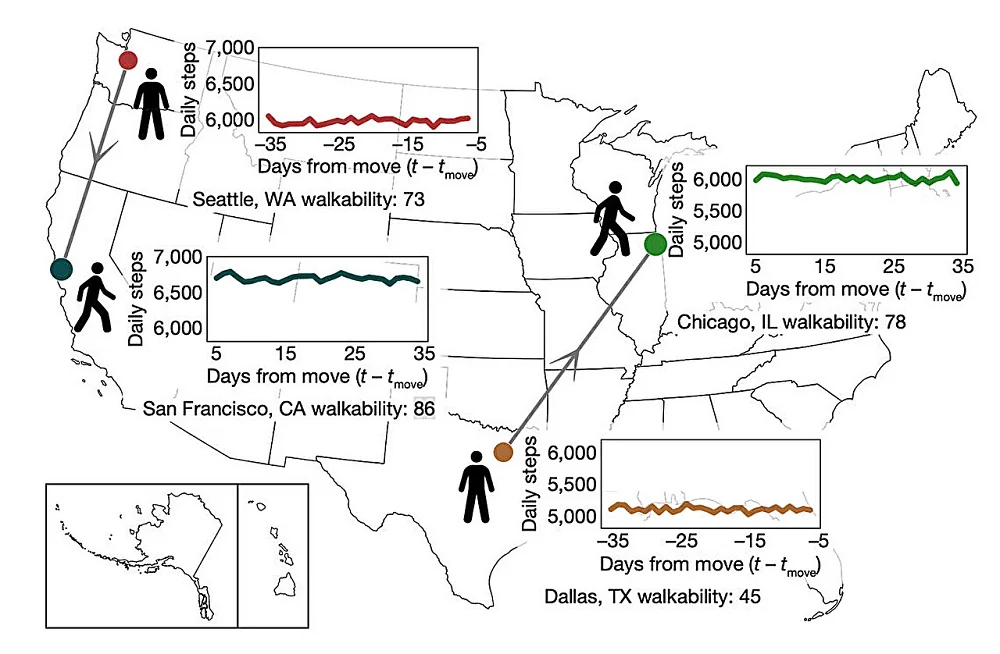Working with data from a smartphone app, scientists have shown for the first time that relocating to a more walkable city is linked to increased daily step counts [1]. Most of the increase consists of moderate-to-vigorous physical activity (MVPA), which is particularly healthy.
A natural experiment in walking
Recent research suggests that even modest increases in physical activity can result in significant health benefits. For instance, walking 7,000 steps per day is associated with a 47% lower risk of all-cause and cardiovascular mortality, a 37% lower risk of cancer mortality, and a 38% lower risk of dementia [2]. However, even hitting this goal might be a problem in a non-walkable environment, which is typical for many US cities.
Some cities are much more walkable than others, but it was previously difficult to get data about how their walkability actually affects the physical activity of their residents. Today, smartphone apps and wearables that provide troves of anonymized real-world data can help researchers determine this.
In a new study from the University of Washington, published in Nature, the researchers asked whether relocation to a more or less walkable city affects the daily number of steps a person takes. They used a large dataset of “248,266 days of minute-by-minute step recordings from 5,424 users of the Azumio Argus smartphone application who relocated at least once within a 3-year observation period.”
In total, the participants relocated 7,447 times among 1,609 US cities, “forming a countrywide natural experiment,” the paper said. The study measured their physical activity longitudinally for up to 90 days before and after relocation, but they also included enough non-relocating participants as controls. Age, gender, and body mass index (BMI) were all accounted for.
More steps and MVPA
The researchers found that moving to a more walkable city was significantly associated with increased daily number of steps. For example, 178 people who relocated to New York City (which sports a particularly high walkability score of 89) from significantly less walkable locations increased their daily step count by 1,400 on average, from 5,600 to 7,000.
Of course, this was not specific to NYC. “Difference in average daily steps aggregated across all relocations. We find that significantly more walkable locations are associated with increases of about 1,100 daily steps, and significantly less walkable locations are associated with similar decreases (for 49-80 point Walk Score increase or decrease),” the authors wrote.

“Some of our prior work suggested that our physical, built environment makes a big difference in how much we move, but we couldn’t produce particularly strong evidence showing that was the case,” said lead author Tim Althoff, a UW associate professor at the Paul G. Allen School of Computer Science & Engineering. “The large data set we worked with for this new study gave us a unique opportunity to produce this strong, compelling evidence that our built environments do indeed causally impact how much we walk.”
The team also investigated whether the higher number of steps resulted in an increase in MVPA, which is considered to be particularly healthy [3]. Indeed, those extra steps were composed mostly of MVPA, corresponding, as the researchers suggest, to brisk walking. They estimated that a large jump in walkability (about 50 points or higher) was associated with one additional hour of MVPA per week.
Walking more was not a choice
The researchers were aware of possible selection effects; for instance, when a person’s move to a more walkable city is in part motivated specifically by its walkability. However, the team reports finding “robust evidence” that their estimates are unlikely to be significantly influenced by such effects. In particular, if participants relocated to higher-walkability areas due to their walkability itself, which would indicate residential self-selection, greater increases in physical activity would be expected compared to decreases observed when moving to lower-activity locations. Yet, the changes observed were symmetric. Additionally, census data indicate that between 77% and 98% of participants who relocate do so for reasons related to family, employment, or housing rather than for walkability considerations.
“Our study shows that how much you walk is not just a question of motivation,” Althoff said. “There are many things that affect daily steps, and the built environment is clearly one of them. There’s tremendous value to shared public infrastructure that can really make healthy behaviors like walking available to almost everybody, and it’s worth investing in that infrastructure.”
This intriguing study highlights the value of big data harvested from mobile and wearable devices, which is playing an increasingly important role in research. It also suggests that walkability should be an important criterion for choosing a place to live and that increasing the walkability of a city is a great way to nudge its inhabitants towards healthier lifestyles.
Literature
[1] Althoff, T., Ivanovic, B., King, A. C., Hicks, J. L., Delp, S. L., & Leskovec, J. (2025). Countrywide natural experiment links built environment to physical activity. Nature, 1-7.
[2] Ding, D., Nguyen, B., Nau, T., Luo, M., del Pozo Cruz, B., Dempsey, P. C., … Owen, K. (n.d.). Daily steps and health outcomes in adults: a systematic review and dose-response meta-analysis. The Lancet Public Health.
[3] Bakker, E. A., Lee, D. C., Hopman, M. T., Oymans, E. J., Watson, P. M., Thompson, P. D., … & Eijsvogels, T. M. (2021). Dose–response association between moderate to vigorous physical activity and incident morbidity and mortality for individuals with a different cardiovascular health status: A cohort study among 142,493 adults from the Netherlands. PLoS medicine, 18(12), e1003845.
View the article at lifespan.io








































